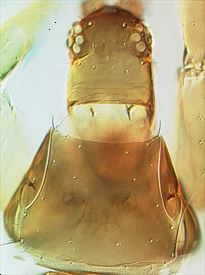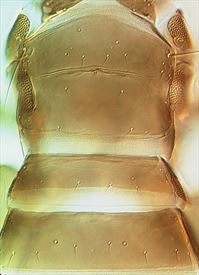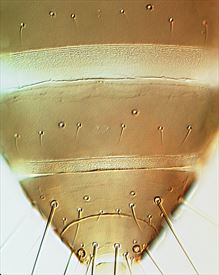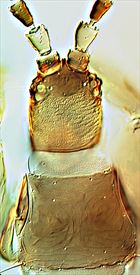Distinguishing features
Both sexes wingless. Antennae 8-segmented, segments III & IV each with a small, circular, lens-shaped sensorium. Head smaller than pronotum, vertex with pair of long ocellar setae. Pronotum trapezoidal, paired longitudinal sutures laterally, one pair of long posteroangular setae. Mesonotum, metanotum and tergites with no lines of sculpture. Tergite IX median setae shorter than sub-median pair; tergite X trichobothria smaller than spiracle on tergite VIII, axial seta short or absent.
Male similar, but vertex developed as extensive pore plate; fore legs enlarged with pointed tubercle at inner apex of tibia; mesonotum, metanotum and tergites with several transverse lines of sculpture.
Related species
Currently 16 species, including three fossil species, are listed in the genus Merothrips, mostly from the Neotropics (Mound & O'Neill, 1974).
Biological data
Breeding on dead leaves and dead branches and presumably feeding on fungal hyphae.
Distribution data
This species was first recorded and described from New Zealand (Three Kings Islands / AK, WO, BP, GB, HB / NN, SD, BR, MC). However, it has also been seen from Australia (Brisbane and Canberra), New Caledonia, and Costa Rica, and is recorded from the Amsterdam and St Paul Islands in the southern Indian Ocean. It probably came originally from somewhere in South America (Mound & Walker, 1982; Mound & O'Neill, 1974).
Family name
MEROTHRIPIDAE
Species name
Merothrips brunneus Ward
Original name and synonyms
Merothrips brunneus Ward, 1969: 362
References
Mound LA & O'Neill K (1974) Taxonomy of the Merothripidae, with ecological and phylogenetic considerations (Thysanoptera). Journal of Natural History 8: 481–509.
Mound LA & Walker AK (1982) Terebrantia (Insecta: Thysanoptera). Fauna of New Zealand 1: 1–113.




